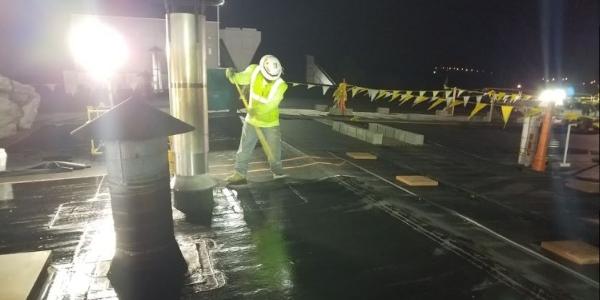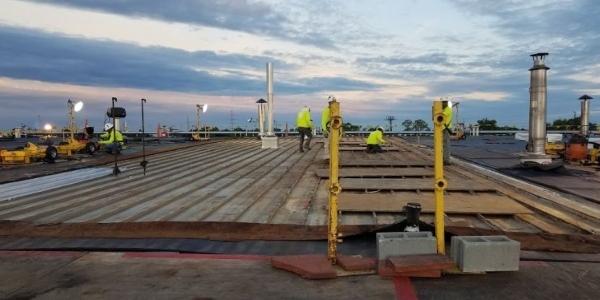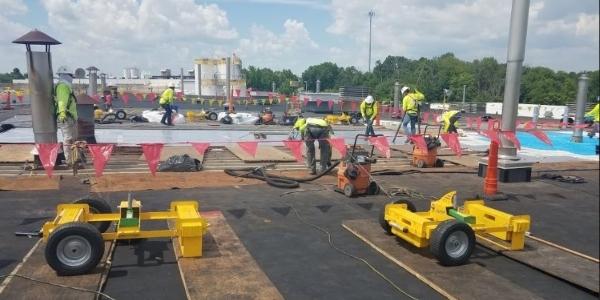2020 Gold Circle Award Winner: Kellogg’s Florence

By Lauren White, RCS Reporter.
Two years, thousands of man hours, and additional precautions were necessary for this factory’s roof replacement.
Unique roofing-related jobs, programs and services are recognized through the prestigious 2020 Gold Circle Awards program. This elite awards program honors Roofing Alliance and National Roofing Contractors Association (NRCA) members for their outstanding contributions to the roofing industry. Each year, members are encouraged to submit their best work in the following categories: Outstanding Workmanship and Innovative Solutions; and Safety Preparedness and Performance.
After two years and 29,069 man hours, CFE, Inc., a subsidiary of Evans Roofing Company, Inc., completed a critical roofing project for Kellogg’s factory in Florence, Kentucky. A full deck and roof system replacement were necessary for this facility. Kellogg’s produces “Ready-to-Eat” (RTE) products and the factory needed to remain operational throughout the process, which posed a challenge for the team at CFE, Inc. They had to complete the project while also preventing salmonella, listeria, and other types of bacteria from entering the facility and compromising the Kellogg’s products being produced.

Once CFE, Inc. was awarded the job, they brainstormed situations that could possibly go wrong with this project, and also figured out ways to prevent and control each of those possibilities. Their associates were sent to a session on RTE products so they could better understand the facility’s manufacturing process from start to finish. After that, they determined the best safety set up for the project.
CFE, Inc. first protected the “high temperature ovens and product line areas by using a high temperature heat resistant interior protection over the entire area,” according to Robert Gilchrist, the President of Gilchrist Safety Solutions, LLC. Two scaffold stair towers were on the outside of the building for access and egress, in addition to an existing fixed ladder. CFA, Inc. had sign in sheets, the JHA (Job Hazard Analysis), and operations of the shift posted. A warning line system was established once work started on the roof, as well as guardrails around the perimeter. “Walkways, ramps and cross over stairs were built to protect the existing roof top,” shared Daniel Nowak, Corporate Risk Manager for Evans Roofing Company, Inc.
Guidelines were strict on the rooftop concerning outside foreign products for fear they would enter the facility. For that reason, no food, tobacco, gum, drinks (except water), or over-the-counter/prescription medications or creams were permitted on the rooftop. The team even went through the first aid kits to remove ointments, swabs, aspirins, etc., and relocated them to the job trailer on the ground, and metal detectable bandages were transferred to the first aid kits at the hydration stations.

24-hour plant shutdowns were scheduled throughout the project per Kellogg’s request. These shutdowns lasted for seven, and sometimes ten days, but allowed the teams to work over critical areas to remove and replace decking. Once CFE, Inc. had the shutdown scheduled, they started organizing their teams to work shifts around the clock. Shifts overlapped by one hour to ensure “all communication was properly exchanged prior to the next shift starting,” Robert explained. Each team started their shift with a tool box talk and developed a JHA for the work that was going to be done during their shift.
The first shift was the night shift. They started by “illuminating the entire project area from the ground up,” Daniel shared. Every hour the wind speed and proper lighting were checked and documented. The team would then “mop down” the area to be removed, which is unusual for a roofing company to do. They used “Bio-Mist,” which is a special, alcohol-based cleaning agent. They used this to help eliminate the chance of any bacteria from entering the facility. After the area was mopped, the team would mark out the area, cut the existing membrane, roll up the membrane and take it to the unloading area.
Once the membrane was removed, the team started taking out insulation and hardboard, exposing the decking. “Two associates would closely follow behind the tear off team with HEPA shop-vacuums to collect any remaining dust or small debris,” explained Daniel. Teams were tied off using mobile fall carts, which were used until ¾” plywood was laid in place, marked, and secured. After the area was cleaned, the team loaded and prepared the roof for the second shift.

When the second shift arrived, the first hour consisted of them reviewing the progress with the first shift team and communicating any hazards. Additional danger warning lines were set up around the area for deck replacement. Six stinger mobile fall protection carts were used. They placed three on each side of the area that was getting removed so the team could still work together but wouldn’t have to cross over openings in the deck. In addition to the carts, teams used full body harnesses and “leading edge” self-retracting life lines.
“As the team began removing a section of old decking other associates were prepping the new stainless steel pan lined decking, which was treated with the “Bio-Mist” cleaning agent,” Robert explained. HEPA shop vacuums were used after each section was removed, but before the new decking was installed, to clean off the interior protection below the roof. This process was necessary to eliminate the possibility of small particles or debris entering the facility.
“Once the freshly sanitized decking was installed and secured, the danger warning lines were removed and the work area was once again cleaned, organized, and set up for the final shift to start their work,” according to Daniel. The third shift also had a safety briefing and hazard communication, like the other two shifts. They “installed DensDeck with a low VOC primer, vapor barrier, then a temporary EPDM membrane, and ensured for water tightness,” explained Robert. This temporary membrane allowed for a faster install, thus helping the facility get back to production.
After the critical areas were finished, the teams went back to only having one shift. They removed the temporary roof like before and added ISO and another layer of DensDeck with a low VOC primer. Then the final membrane was installed.
Safety was a top priority for the CFE, Inc. team. According to Daniel, “Each shift inspected every piece of equipment, scaffolding, fall protection, electrical cords and tools.” On site for every shift there was a designated board certified safety professional, project management, operations management, third party construction consultation, and a third party engineer. “...This was a very safe, well structured, and organized project from start to finish,” Robert shared. And there wasn’t a single incident or accident throughout the entire process.
This was a challenging project that CFE, Inc. took on. They were confident in their abilities and developed well thought out safety, quality, and customer satisfaction plans that put Kellogg’s needs first. Daniel shared, “The team at Kellogg’s was truly impressed by the concern and concentration CFE, Inc. implemented to give them an outstanding final product to protect their very livelihood of manufacturing the ready-to-eat products that we all enjoy!”
For more information on the Gold Circle awards plus information about the Roofing Alliance contact Bennett Judson, the Roofing Alliance’s executive director, at bjudson@roofingalliance.net or visit www.roofingalliance.net.




















-2025-xtv-mls-tour-2.png)


Comments
Leave a Reply
Have an account? Login to leave a comment!
Sign In